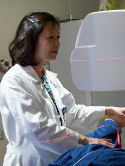Bilateral implant reconstruction does not affect the quality of postmastectomy radiation therapy Journal Article
| Authors: | Ho, A. Y.; Patel, N.; Ohri, N.; Morrow, M.; Mehrara, B. J.; Disa, J. J.; Cordeiro, P. G.; Shi, W.; Zhang, Z.; Gelblum, D.; Nerbun, C. T.; Woch, K. M.; Ballangrud, A.; McCormick, B.; Powell, S. N. |
| Article Title: | Bilateral implant reconstruction does not affect the quality of postmastectomy radiation therapy |
| Abstract: | To determine if the presence of bilateral implants, in addition to other anatomic and treatment-related variables, affects coverage of the target volume and dose to the heart and lung in patients receiving postmastectomy radiation therapy (PMRT). A total of 197 consecutive women with breast cancer underwent mastectomy and immediate tissue expander (TE) placement, with or without exchange for a permanent implant (PI) before radiation therapy at our center. PMRT was delivered with 2 tangential beams + supraclavicular lymph node field (50Gy). Patients were grouped by implant number: 51% unilateral (100) and 49% bilateral (97). The planning target volume (PTV) (defined as implant + chest wall + nodes), heart, and ipsilateral lung were contoured and the following parameters were abstracted from dose-volume histogram (DVH) data: PTV D95% > 98%, Lung V20Gy > 30%, and Heart V25Gy > 5%. Univariate (UVA) and multivariate analyses (MVA) were performed to determine the association of variables with these parameters. The 2 groups were well balanced for implant type and volume, internal mammary node (IMN) treatment, and laterality. In the entire cohort, 90% had PTV D95% > 98%, indicating excellent coverage of the chest wall. Of the patients, 27% had high lung doses (V20Gy > 30%) and 16% had high heart doses (V25Gy > 5%). No significant factors were associated with suboptimal PTV coverage. On MVA, IMN treatment was found to be highly associated with high lung and heart doses (both p < 0.0001), but implant number was not (p = 0.54). In patients with bilateral implants, IMN treatment was the only predictor of dose to the contralateral implant (p = 0.001). In conclusion, bilateral implants do not compromise coverage of the target volume or increase lung and heart dose in patients receiving PMRT. The most important predictor of high lung and heart doses in patients with implant-based reconstruction, whether unilateral or bilateral, is treatment of the IMNs. Refinement of radiation techniques in reconstructed patients who require comprehensive nodal irradiation is warranted. © 2014 American Association of Medical Dosimetrists. |
| Keywords: | implant; breast cancer; immediate reconstruction; postmastectomy radiation |
| Journal Title: | Medical Dosimetry |
| Volume: | 39 |
| Issue: | 1 |
| ISSN: | 0958-3947 |
| Publisher: | Elsevier Science, Inc. |
| Date Published: | 2014-01-01 |
| Start Page: | 18 |
| End Page: | 22 |
| Language: | English |
| DOI: | 10.1016/j.meddos.2013.08.008 |
| PROVIDER: | scopus |
| PUBMED: | 24238837 |
| DOI/URL: | |
| Notes: | The publisher's record lists the publication date as Spring -- Export Date: 3 March 2014 -- CODEN: MEDOE -- Source: Scopus |
Altmetric
Citation Impact
BMJ Impact Analytics
MSK Authors
Related MSK Work














